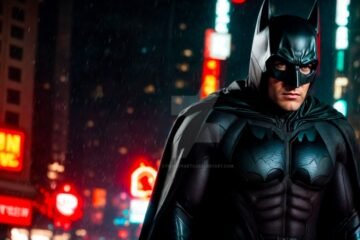Cinematic classics, or classic films, are movies that have stood the test of time and remain beloved by moviegoers throughout the years. They are often thought of as timeless works of art, and for good reason. Cinematic classics have left a lasting impact on the film industry, inspiring countless filmmakers and providing a source of enjoyment for generations.
From the silent films of the early 20th century to the blockbuster hits of today, cinematic classics have made a lasting impression on all who have seen them, leaving viewers both moved and inspired. These films may be decades or even a century old, but they still possess the power to captivate and entrance viewers. In addition to their entertainment value, classic films are an important part of cultural history and can provide insight into the values and beliefs of a given era. As such, studying cinematic classics is essential for understanding the evolution of film and its role in our culture.
Cinematic classics are more than just entertainment; they are a window into our past, a source of inspiration, and a reminder of the power of art. By studying these timeless works of art, we can gain insight into the history of film and its impact on our culture. So whether you are a budding filmmaker or simply a movie lover, it is essential to study cinematic classics in order to gain a deeper understanding of the film industry and its lasting impact.

What makes a film a cinematic classic?
Criteria for Defining a Cinematic Classic
When trying to define a cinematic classic, there are several criteria to consider. One of the most important criteria is the film’s quality, which can be determined by its technical aspects such as cinematography, sound, and acting. A classic film should also have a unique plot, with a well-crafted narrative structure that lasts the test of time. Additionally, a classic film should also have a cultural significance, with its themes being relevant to the audience at the time of its release and still relevant today. Finally, a classic film should have a certain timelessness about it, with its themes and messages being consistent across generations.
Examples of Films that Meet These Criteria
There are many films that meet the criteria for being considered a cinematic classic. Some examples include The Godfather (1972), Casablanca (1942), Citizen Kane (1941), Schindler’s List (1993), and The Shawshank Redemption (1994). All of these films have stellar technical aspects, a unique plot and narrative structure, cultural significance, and a timeless quality that makes them stand out from other films.
Evolution of cinematic classics over time
Cinematic classics are films that have had a profound impact on the industry and have been remembered for a long time. Throughout the decades, there have been a wide range of cinematic classics that have shaped the way we view films today. These films have made a lasting impression on the industry and have been praised for their innovation and powerful storytelling.
Examples of cinematic classics from different eras
Some of the earliest cinematic classics are from the silent era, such as Charlie Chaplin’s The Kid (1921) and Buster Keaton’s The General (1926). These films used physical comedy and clever editing techniques to create some of the most memorable moments in film history. From the 1940s, films such as Casablanca (1942) and Citizen Kane (1941) were hailed as groundbreaking pieces of art that pushed the boundaries of the medium. The 1950s saw the emergence of epic dramas such as The Searchers (1956) and Giant (1956), while the 1960s and 1970s saw the rise of classic comedies such as The Graduate (1967) and Saturday Night Fever (1977). The 1980s and 1990s saw the emergence of action-packed blockbusters such as Die Hard (1988) and Jurassic Park (1993).
Changes in film-making techniques and how they have affected the concept of cinematic classics
Over the years, film-making techniques have changed drastically. The introduction of sound, color, and special effects has revolutionized the way films are made and have made it possible for filmmakers to create more complex stories. This has allowed for more intricate and ambitious stories to be told, and has allowed filmmakers to push the boundaries of what is possible in cinema. As a result, the concept of what makes a cinematic classic has evolved. While the basics of storytelling remain the same, the use of new techniques has allowed filmmakers to create more visually stimulating and emotionally powerful films that have become classics in their own right. From computer-generated imagery to elaborate production design, innovative techniques have allowed filmmakers to create films that would have been impossible in the past.
The impact of cinematic classics on society
The impact of cinematic classics on society has been immense. Films have the power to influence people’s perspectives, bring attention to important issues, and even change the course of history. Cinematic classics have had a significant impact on society and culture, often leaving a lasting impression.
One of the most recognizable and impactful cinematic classics is 12 Angry Men (1957). This film is an example of how cinema can be used to spark conversations and debate on important issues. The story follows a jury of twelve men who are tasked with deciding the fate of a young man accused of murder. Throughout the film, the men debate the facts of the case and their own preconceptions, ultimately leading to a unanimous verdict of “not guilty”. 12 Angry Men served to challenge the values of its audience, inspiring them to think for themselves and consider the complexities of a situation before forming an opinion.
Other classic films that have had a significant impact on society include The Wizard of Oz (1939), Gone With the Wind (1939), and Casablanca (1942). The Wizard of Oz is considered one of the most influential films of all time and has served as a source of comfort and hope to many. This film showed viewers that hope can be found even in the darkest of times, and that the power of friendship and determination can help us to make it through any challenge. Gone With the Wind is renowned for its epic romance, but also for its portrayal of the Civil War and its aftermath. The film has been credited with helping to shape popular opinions about the Reconstruction period and has been said to have had a lasting effect on how the Civil War is remembered. Finally, Casablanca has been hailed as a masterpiece of cinema and has been praised for its timeless themes of love, loyalty, and sacrifice. This classic film has been said to have shaped the way we think of romantic love and has become a cultural icon.
The role of directors and actors in cinematic classics
The director and actors of a movie play a crucial role in creating cinematic classics. The director is the one who sets the vision and tone of the movie, while the actors bring the characters to life on the big screen. Directors and actors have the power to influence audiences through their performances and stories.
Significance of the Director and Actors
The director is the one who is responsible for the overall vision and tone of the movie. Directors are the ones who decide how the story is going to be told and how the shots should be composed. Directors also decide on the casting of actors, as they are the ones who will be responsible for bringing the characters to life.
Actors are the ones who are responsible for bringing the characters to life on the big screen. They are the ones who are responsible for embodying the characters and making them feel real to the audience. Actors have the power to influence audiences with their performances and stories.
Examples of Directors and Actors
There are many directors and actors who have made significant contributions to the film industry. Some examples of directors include Alfred Hitchcock, Stanley Kubrick, and Quentin Tarantino. These directors have created some of the most iconic films in cinematic history.
Some examples of actors who have made significant contributions to the film industry include Marlon Brando, Robert De Niro, and Meryl Streep. These actors have delivered some of the most memorable performances in cinematic history.
Analyzing cinematic classics
Techniques for Analyzing Cinematic Classics:
• Analyzing the narrative structure of the film: This involves looking at the plot and how it develops over the course of the movie. This can include looking at the characters, their motivations, as well as the overall theme of the film.
• Examining the cinematography: This includes looking at the way scenes are composed and lit, as well as the use of camera angles, shot selection, and other visual elements.
• Analyzing the musical score: This involves looking at the way the music supports the visuals and how it enhances the emotional impact of the movie.
• Analyzing the performances: This involves looking at the way the actors deliver their lines, as well as the way their characters are portrayed.
• Investigating the directorial style: This involves looking at the way the director uses various techniques to convey their message, such as blocking, camera movement, and editing.
Examples of Films That Have Been Extensively Analyzed and Studied:
• Citizen Kane (1941): This classic film has been extensively analyzed and studied due to its complex narrative structure, innovative use of cinematography, and groundbreaking performance by Orson Welles.
• Psycho (1960): This classic horror film has been extensively analyzed and studied due to its unique narrative structure, innovative use of camera angles, and iconic performance by Anthony Perkins.
• 2001: A Space Odyssey (1968): This classic science-fiction film has been extensively analyzed and studied due to its experimental use of cinematography, groundbreaking use of special effects, and iconic performance by Keir Dullea.
• The Godfather (1972): This classic gangster film has been extensively analyzed and studied due to its complex narrative structure, iconic performances by Marlon Brando and Al Pacino, and innovative use of camera angles.
• Annie Hall (1977): This classic comedy has been extensively analyzed and studied due to its innovative use of editing, iconic performance by Woody Allen, and groundbreaking use of music.
The future of cinematic classics
The future of cinematic classics is an exciting and ever-evolving concept. With the advent of streaming services, more movies than ever before are accessible to viewers, allowing for more possibilities for what can be considered a classic. As a result, the potential for cinematic classics of the future is limitless.
In order to become a classic, a movie must be timeless and have a strong impact on the audience. It should be able to appeal to viewers from all generations, and its themes should be relevant to a modern audience. Movies that have strong characters, captivating storytelling, and memorable moments are more likely to become a classic.

Examples of movies that could potentially become cinematic classics in the future include:
– Get Out (2017): This movie takes a look at racism and the horror of being an outsider in a society through a thrilling and suspenseful plot.
– Parasite (2019): This movie examines class differences in a captivating and thought-provoking way.
– Lady Bird (2017): This movie tells a heartfelt coming of age story set in a relatable setting.
– The Farewell (2019): This movie tells a touching and emotionally resonant story of a family coming together in the face of tragedy.
In the future, cinematic classics will be defined by a variety of factors. Movies that are able to leave a lasting impression on viewers, contain strong characters, and have themes that resonate with a modern audience will be more likely to become classics. With streaming services making a wider variety of movies more accessible, the potential for cinematic classics of the future is limitless.
Conclusion
Cinematic Classics have had a profound impact on our culture, providing us with a unique insight into the minds and motivations of the people who created them. From the classic films of the Golden Age of Hollywood to the modern masterpieces of the 21st century, these films have provided us with timeless lessons about life, love, and the power of imagination. The films have also given us a greater appreciation for the power of cinema, and the beauty of storytelling. They have also inspired countless filmmakers to take risks and push the boundaries of their craft. As the art of cinema continues to evolve and expand, it is certain that these timeless films will remain an integral part of our culture for generations to come, and will continue to shape the way we view our world.
FAQs
1. What is Cinematic Classics?
Cinematic Classics is a study of timeless films, their impact on society and their continued relevance in the modern world. It explores the artistry of classic films, their influence on popular culture, and the impact of their themes on our lives.
2. What types of films are included in Cinematic Classics?
Cinematic Classics includes a variety of genres, such as comedy, drama, romance, suspense, sci-fi, horror, musicals, and documentaries. All of these genres are studied in their own unique ways to better understand their impact and relevance.
3. What topics are covered in Cinematic Classics?
The topics covered in Cinematic Classics include the history of film, its influence on popular culture, and its impact on society. It also covers the impact of themes in classic films, the evolution of film genres, and the influence of directors on their films.
4. Who should take Cinematic Classics?
Cinematic Classics is suitable for anyone interested in the history, artistry, and influence of classic films. It is especially suitable for people interested in the film industry, film studies, or the history of cinema.
5. What will I learn from taking Cinematic Classics?
By taking Cinematic Classics, you will gain a deeper understanding of classic films, their impact on society, and their relevance in the modern world. You will learn about the evolution of film genres, the influence of directors on their films, and the impact of themes in classic films.
6. What is the benefit of taking Cinematic Classics?
Taking Cinematic Classics will help you gain a greater appreciation for the artistry of classic films, the impact of their themes on our lives, and the influence of their directors on our culture. It will also give you a better understanding of the history of film and its relevance in the modern world.
7. What makes Cinematic Classics unique?
Cinematic Classics is unique in its approach to studying classic films. It combines the history of film with its influence on popular culture, the impact of its themes on our lives, and the evolution of film genres. This makes it an ideal course for anyone interested in the film industry, film studies, or the history of cinema.
8. How long does it take to complete Cinematic Classics?
Cinematic Classics typically takes about 15-20 hours to complete.
9. Is there a certification for completing Cinematic Classics?
Yes, there is a certification available for completing Cinematic Classics. The certification will be issued by the institution offering the course.
10. What are the prerequisites for taking Cinematic Classics?
There are no prerequisites for taking Cinematic Classics. All that is required is an interest in the history, artistry, and influence of classic films.


















